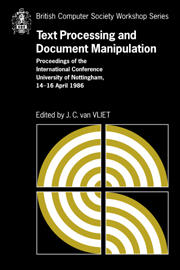 Text Processing and Document Manipulation
Text Processing and Document Manipulation Published online by Cambridge University Press: 05 May 2010
ABSTRACT
An important goal of document preparation systems is that they be deviceindependent, which is to say that their output can be produced on a variety of printing devices. One way of achieving that goal is to devise a device-independent page description language, which can describe precisely the appearance of a formatted page, and to produce software that prints the required image on each variety of printer. Most attempts at device-independent page description languages have failed, resulting either in schemes that are only partially device-independent or in proclamations from researchers that device independence is a bad idea [2, 4].
A new generation of procedural page description languages promises a solution. The PostScript language, and to a lesser extent the Interpress language, offers a means of describing a printed page with an executable program; the page is printed by loading the program into the printer and running it.
Page Description Languages
An imaging device, such as a typesetter, laser printer, or display, must have some way of knowing what image it is being asked to show. The two traditional means of providing it with that information have been to describe the image to the imager in terms of a bitmap or character map or describe the image to the imager by means of a sequence of control commands to the imager's electronics.
The bit-map or character-map schemes are the simplest and oldest. For example a line printer is provided with a character map (in this spot put the character in this spot put the character and so forth).
To save this book to your Kindle, first ensure [email protected] is added to your Approved Personal Document E-mail List under your Personal Document Settings on the Manage Your Content and Devices page of your Amazon account. Then enter the ‘name’ part of your Kindle email address below. Find out more about saving to your Kindle.
Note you can select to save to either the @free.kindle.com or @kindle.com variations. ‘@free.kindle.com’ emails are free but can only be saved to your device when it is connected to wi-fi. ‘@kindle.com’ emails can be delivered even when you are not connected to wi-fi, but note that service fees apply.
Find out more about the Kindle Personal Document Service.
To save content items to your account, please confirm that you agree to abide by our usage policies. If this is the first time you use this feature, you will be asked to authorise Cambridge Core to connect with your account. Find out more about saving content to Dropbox.
To save content items to your account, please confirm that you agree to abide by our usage policies. If this is the first time you use this feature, you will be asked to authorise Cambridge Core to connect with your account. Find out more about saving content to Google Drive.